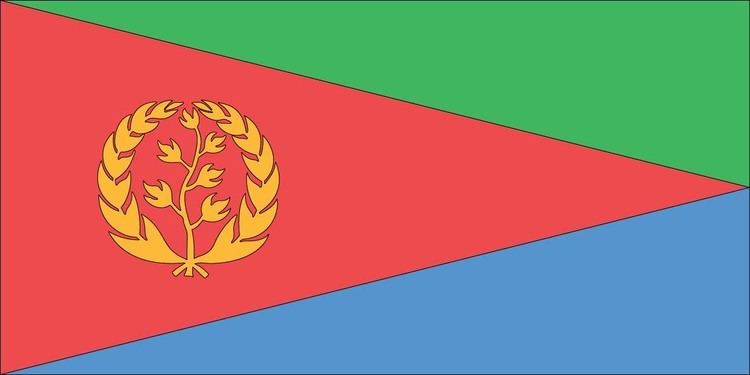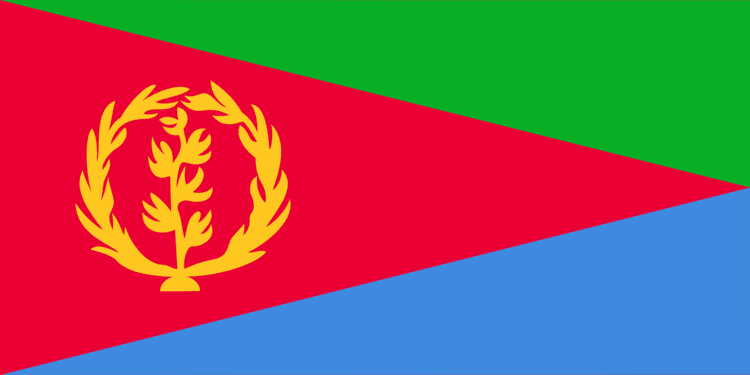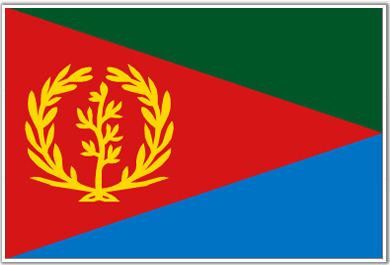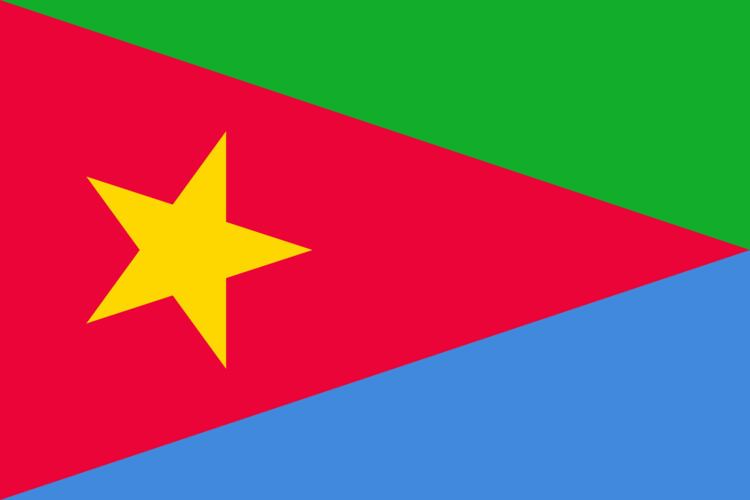Proportion 1:2 | Adopted on 5 December 1995 | |
Design a red isosceles triangle based on the hoist-side pointed toward the fly-side and then divided into two right triangles: the upper triangle is green and the lower triangle is blue with an Emblem (1952-1962) in gold (a vertical olive branch encircled by an olive wreath) centered on the hoist side of the triangle | ||
National flag of eritrea
The national flag of Eritrea, as adopted on December 5, 1995, bears a resemblance to the official flag of the Eritrean People's Liberation Front. The wreath with the upright olive-branch symbol derived from the 1952 flag, which had a light blue background to honour the United Nations. The green color in the flag stands for the agriculture and livestock of the country, the blue stands for the sea, and the red for the blood lost in the fight for freedom.
Contents

The flag has proportions of 1:2.
Flag of eritrea
History and symbolism

Eritrea and Ethiopia were both occupied by the Italians, who ruled them as a single possession between 1935-1941. Before the Second World War, Eritrea was more developed and prosperous than Ethiopia. After Italy's defeat in the war, Ethiopia reverted to its pre-Italian feudal monarchy while Eritrea was given over to modern British rule under a mandate by the United Nations in 1949. The advent of Arab nationalism in the 1940s saw the Muslim part of Eritrea demand independence from British rule. Meanwhile, Ethiopia tried to claim the Eritrean state as its own by calling it a "lost province". Several officers proposed that Eritrea be separated into two parts: the Christian area to be merged to Ethiopia; the Muslim area to Sudan. After international debate and the intervention of the Allied Powers, the United States passed a resolution with the agreement of Britain formulating the creation of an autonomous Eritrea in federation with Ethiopia in 1950.

On September 15, 1952, Eritrea became independent from British rule and was made an autonomous part of Ethiopia. Since the United Nations had helped the country obtain independence from British rule, the 1952 Eritrean flag was designed with a light blue background to honour the organisation's assistance. The flag at that time had an olive wreath in the centre, symbolising peace. The wreath encircled a six-leafed plant which represented the six administrative divisions of Eritrea.

After civil war broke out in Eritrea in 1961, Ethiopian emperor Haile Selassie banned the Eritrean flag, coat of arms, and all other government seals from public places. He annexed Eritrea in 1962 with the approval of the United Nations.
The Eritrean People's Liberation Front fought for the country's independence, and in January 1977, the party adopted its own official flag. The current flag of Eritrea bears resemblance to the party's official flag. The flag had three triangles: red, blue, and green. The yellow star in the red triangle symbolised the country's rich mineral resources. After Eritrea was proclaimed an independent nation, the flag was modified and its first official hoisting was performed on May 24, 1993. In the red triangle, a gold wreath symbol with 14 leaves on each side, derived from the 1952 flag, replaced the gold star of the Eritrean People's Liberation Front's flag. In 1995 the number of leaves in the wreath were standardised. The 30 leaves symbolise the number of years spent in civil war before achieving independence. The flag's length to breadth ratio was changed from 2:3 to 1:2.
The official currency of Eritrea's Nakfa coins issued in 1991 featured six native animals; on the reverse the coins showed a group of Eritrean People's Liberation Front's fighters raising the national flag and the slogan "Liberty, Equality and Justice" in English language.
Description
The flag is dominated by a red isosceles triangle based on the hoist-side pointed toward the fly-side and then divided into two right triangles: the upper triangle is green and the lower triangle is blue with an Emblem (1952-1962) in gold (a vertical olive branch encircled by an olive wreath) centered on the hoist side of the triangle. The CIA World Factbook 2012 points out that the shape of the red triangle mimics the shape of the country. Green stands for the agriculture and livestock of the country, blue for the sea (Red Sea), and red for the blood lost in the fight for freedom.
